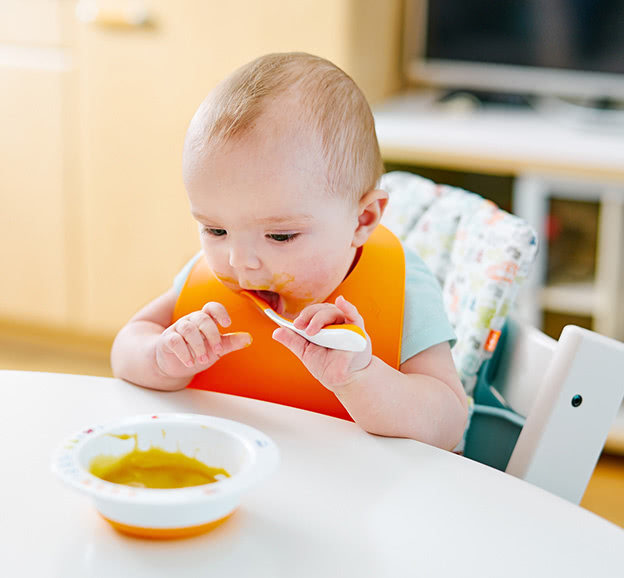
Section
Starting Solid Food
Breastmilk or formula is your baby’s only food until she is about 6 months old. After that, it is still her main food, but you can start to add soft cereal or mashed food.
Where to Find Help
Information and referral to services, including food assistance and disaster help.
2-1-1
Advice and classes on breastfeeding and healthy eating; food coupons for women with low incomes.
1-800-852-5770
Things You Can Do
More Sleep Safety Tips
Feeding Your Baby Safely
Always wash your hands before filling a bottle or feeding your baby.
Wash your baby’s hands before she eats.
Be sure to test how hot the food or liquid is before you give it to your baby. Do not heat formula or food in the microwave.
Wash fruits and vegetables.
Do not put cereal in a baby bottle.
Do not give your baby honey before she is 1 year old. It can poison her.
Do not use cow’s or goat’s milk instead of breastmilk or formula. They do not have the nutrition your baby needs.
To Prevent Choking
Watch your baby the whole time that she is eating. If she chokes, she cannot make noise to let you know.
Cut food into small pieces. Remove bones, seeds, and pits.
Avoid tough foods like large dried fruit or pieces of meat.
Avoid hard foods like raw carrots, nuts, and popcorn.
Take a first aid class so you know what to do if your child chokes.
To Help with Diaper Rash
Diaper rash is common between 8 and 10 months, when babies start to eat more solid food.
Change her diaper often to keep her as dry as possible.
Clean her bottom with warm water and a soft cloth, and pat it dry.
Leave her diaper off for short periods to let her skin dry.
To protect her skin, apply petroleum jelly (Vaseline) or zinc oxide.
If she has blisters or open sores, or if the rash doesn’t clear up in 2 or 3 days, call the doctor.
Avoid Juices
Don’t give your child any juice before she is a year old. After she is a year old, give her no more than ¼ cup a day. Juice drinks have added sugar, so they are not a healthy drink.
Your Baby Shows She Is Ready
You can try solid food when your baby is 6 months old and:
Can hold her head steady by herself.
Can sit up with support.
Can close her mouth around a spoon.
Can swallow food, not spit it out.
Shows she doesn’t want food by turning her head.
Your Baby’s First Solid Food (6 to 8 months)
Start with small spoonfuls of baby cereal or pureed vegetables, fruit, or meat. You can mix cereal with water, breastmilk, or formula. Your baby still needs breastmilk or formula several times a day.
Finger Foods, Cups, and Spoons (9 to 12 months)
Your baby can begin to eat finely chopped meat, fish, tofu, cheese, cooked vegetables, and fruit. Do not add salt, sugar, or spices. Over time, offer her many different kinds of foods.
She still needs breastmilk or formula. But do not give her more than 3 bottles or cups (24 ounces) a day. More can take away her appetite for solid food.
Be patient as your baby learns to feed herself. Include her at the family table, and understand that she will be messy.

Be patient as your baby learns to feed himself.
About Allergies
Try one new food at a time. Try it for a few days, and watch for allergic reactions, like skin rashes, gas, diarrhea, or trouble breathing. If she has a reaction, stop feeding the new food, and talk with your baby’s doctor.
Weaning
Switching your baby from breastmilk or formula to other foods is known as “weaning.” Here is how to do it:
From breastfeeding: Try to breastfeed for at least a year. There are benefits to breastfeeding longer, up to 2 years and more. When you wean your baby, go slowly. Drop midday feedings first. Then drop morning feedings. Drop evening feedings last.
From the bottle: Start weaning at 12 to 18 months. To help her be ready, start to give her formula, breastmilk, or water from a sippy cup at 6 to 9 months.